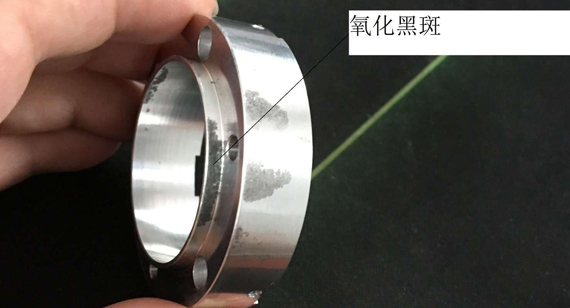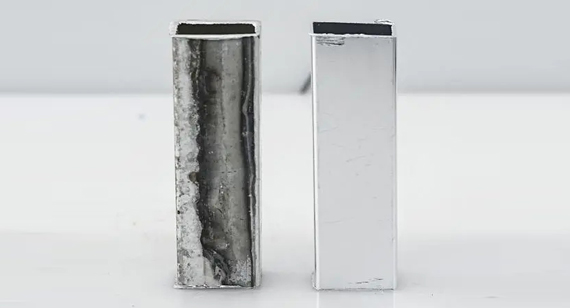The appearance of black spots or streaks on 7075 aluminum after CNC machining can be attributed to various factors. Here are some potential reasons for black spot formation on CNC machined 7075 aluminum:

1. Tool Material and Coating: The choice of cutting tools and their coatings can affect the generation of black spots. If the tool material or coating is not suitable for aluminum machining, it can lead to excessive tool wear and material transfer to the aluminum surface, resulting in black spots.
2. Tool Wear: Worn-out cutting tools can generate friction and heat during machining. This can cause aluminum to adhere to the tool’s cutting edges and transfer onto the workpiece, leaving behind black marks.
3. Coolant Contamination: Contaminated or aged cutting fluids/coolants can contribute to the formation of black spots. When cutting fluids become contaminated with foreign particles or are not properly maintained, they can lead to inadequate lubrication and heat dissipation, increasing the risk of material transfer and black spotting.
4. Cutting Speed and Feed Rate: Incorrect cutting speeds and feed rates can generate excessive heat during machining. This heat can lead to material transfer from the tool to the workpiece, resulting in black marks.
5.Tool-Chip Interaction: The interaction between the cutting tool and the generated chips can cause material transfer and black spotting. Proper chip evacuation and control are crucial to prevent this issue.
6. Material Properties: The specific properties of 7075 aluminum, such as its hardness and the tendency to generate fine chips, can influence black spot formation. Adjusting cutting parameters and tooling to match these properties can help mitigate the issue.
7. Contaminated Workholding: If the workholding fixtures or clamps used to secure the aluminum workpiece are contaminated with foreign substances, these contaminants can transfer onto the workpiece surface during machining, leading to black spots.
8. Material Quality Issues: Poor-quality aluminum material with impurities or defects can contribute to black spot formation.
9. Excessive Machining Temperatures: Elevated machining temperatures can result in the volatilization of surface materials, which may contribute to black spot formation.
10. Inadequate Cooling Time and Machining Parameters: Improper cooling and incorrect machining parameters can lead to overheating and potential material transfer, causing black spots.
To address and prevent black spot issues in 7075 aluminum CNC machining, it’s essential to:
1. Select appropriate cutting tools designed for aluminum.
2. Monitor and replace worn tools regularly.
3. Maintain clean and uncontaminated cutting fluids/coolants.
4. Optimize cutting parameters for 7075 aluminum.
5. Ensure effective chip evacuation.
6. Keep workholding fixtures and clamps clean and free of contaminants.
7. Verify the quality of the aluminum material being used.
8. Control machining temperatures and parameters adequately.
By addressing these factors and maintaining proper machining practices, you can reduce the likelihood of black spot formation during CNC machining of 7075 aluminum.
Regarding the issue of woodgrain-like black marks appearing on 7075 aluminum after anodization, several factors could contribute to this phenomenon:

Chemical Reactions During Anodization: During the anodization process, chemical reactions occur at the surface of the aluminum alloy. In the case of 7075 aluminum, which contains a relatively high amount of zinc, specific reactions may result in the formation of black streaks or marks on the surface.
1. Improper Anodization Conditions: Factors such as anodization time, current density, and the concentration of the electrolyte solution can influence the quality and appearance of the anodized layer. Inadequate control of these conditions may lead to the formation of black streaks.
2. Contaminated Workpieces: Surface contamination, such as oils, fingerprints, or dust, on the aluminum workpieces before anodization can contribute to black marks during the process.
3. Electrolyte Contamination: Impurities or contaminants in the anodizing electrolyte solution can also result in the formation of black streaks on the anodized surface.
In summary, the reasons for the occurrence of woodgrain-like black marks on 7075 aluminum after anodization require further analysis. It may involve adjusting anodization parameters, ensuring the cleanliness of the workpieces, and maintaining the purity of the electrolyte solution to improve the quality and appearance of the anodized layer.
Looking for a reliable cooperative CNC machining factory
Are you looking for the right CNC machining manufacturer? Why not give CNCMF CNC machining factory a try and let us help you.
We provide customized CNC machining services for aluminum, stainless steel, titanium, copper and other metal materials. Focusing on CNC machining and production for 13 years, we have a surface treatment factory that we have cooperated with for 10 years, providing various surface treatment services. Whether it is prototype CNC machining manufacturing or low-volume CNC machined parts production, our team of professional engineers will choose the appropriate CNC machining process and surface treatment issues for you to obtain high-quality CNC machined parts. Now, just upload your CAD files to our email: [email protected] to get a project quote.